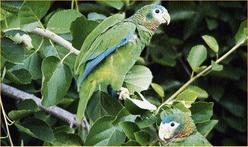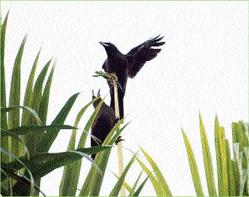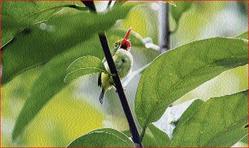Keisha Shakespeare-Blackmore, Staff Reporter

Birds are the envy of some animals because of their ability to take flight. And Jamaica has its fair share of its beautiful winged friends.
Jamaica has over 300 different species, over 100 resident land- breeding birds and 27 which are endemic to the island. In the coming months, Lifestyle, with the assistance of the Bird Life Association of Jamaica, will feature these magnificent winged animals, especially those endemic to the island. This week, we feature three of the 27 endemic birds (the Tody, Yellow-billed Parrot, and the Jamaican Crow).
- Source: John Fletcher: president of the Bird Life Association of Jamaica.
www.wikipedia.com
The Yellow-billed Parrot (Amagana Colaris)

Yellow-billed Parrot - Contributed photos
Jamaica is home to two endemic parrots, the Yellow and Black-billed Parrots. They live mainly in undisturbed forest areas, such as the Cockpit Country in Trelawny and John Crow Mountains in Portland. Despite illegal activities to capture and sell them, they thrive because of the remoteness of much of their habitat.
There is, however, a flock of about 50 Yellow-billed Parrots that live permanently in Hope Gardens. They are fairly tame, and in the mornings, you can hear them in the trees. Hope Gardens is a very good place to get a good view of these beautiful birds.
They have brilliant red, yellow and blues outer feathers. They make their nests in hollow trees to protect them from predators, such as rats, snakes and other birds, such as the Jamaica Crow. Hunters trying to capture the young birds sometimes cut down nesting trees. Often injuring the young and depriving them of a future nesting site. In recent years, the authorities have become more aware of the dangers of these illegal activities and have brought some people before the courts.
The Jamaican Crow (Corvus jamaicensis)

Jamaican Crow
The Jamaican Crow is a small crow species, 35 to 38 centimetres in length. It is closely related to two other West Indian species, the Cuban Crow (Corvus nasicus), and the White-necked Crow (Corvus leucognaphalus) of Hispaniola. They are usually found in woodland mixed with cleared areas and gardens. Though they tend to favour the hill and mountain forest, they usually come down to lower elevations during the dry season where they are more likely to be seen.
They are grey in appearance, not glossy like near relatives, but possess a similar dark grey patch of naked skin just behind the eye and a smaller naked patch at the base of the bill. The bill itself is slate-grey, and nasal bristles are relatively sparse, usually leaving the nostrils to view.
By nature, a forest crow feeds mostly on fruits and usually seeks food in trees in pairs or small groups. They also probe under bark and leaf litter for small invertebrates. They are known to raid other birds' nests of eggs and nestlings.
Their nests are usually built in tall trees though this species may also use tree holes as a possible nesting option. So far, there is limited information recorded of this specie and its breeding habits.
The Jamaican Tody

Jamaican Tody
The Jamaica Tody is the jewel of the Jamaican bird world.
It is a tiny but brilliant coloured emerald green and scarlet bird. No bigger than a leaf, its green colour makes for great camouflage. This bird is often present in the woods and gardens. You are more likely to hear its unique sharp 'chit-chit' chirp before seeing it.
The Tody is not a shy bird and will allow you to observe it closely. Todies make their nest by excavating a tunnel in a riverbank or hillside. They are often seen sitting on a nearby twig, guarding the small entrance.
The Tody family consists of only five species which are found exclusively in the islands of the Greater Antilles, Jamaica, Cuba, Hispaniola and Puerto Rico. The differences among the species are slight but make them unique in the world of birds.

